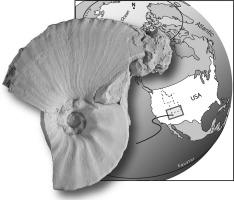当前位置:
X-MOL 学术
›
Glob. Planet. Change
›
论文详情
Our official English website, www.x-mol.net, welcomes your
feedback! (Note: you will need to create a separate account there.)
New middle and late Smithian ammonoid faunas from the Utah/Arizona border: New evidence for calibrating Early Triassic transgressive-regressive trends and paleobiogeographical signals in the western USA basin
Global and Planetary Change ( IF 4.0 ) Pub Date : 2020-09-01 , DOI: 10.1016/j.gloplacha.2020.103251 Arnaud Brayard , Nicolas Olivier , Emmanuelle Vennin , James F. Jenks , Kevin G. Bylund , Daniel A. Stephen , Dawn McShinsky , Nicolas Goudemand , Emmanuel Fara , Gilles Escarguel
Global and Planetary Change ( IF 4.0 ) Pub Date : 2020-09-01 , DOI: 10.1016/j.gloplacha.2020.103251 Arnaud Brayard , Nicolas Olivier , Emmanuelle Vennin , James F. Jenks , Kevin G. Bylund , Daniel A. Stephen , Dawn McShinsky , Nicolas Goudemand , Emmanuel Fara , Gilles Escarguel

|
Abstract New Smithian (Early Triassic) ammonoid assemblages were sampled near the Utah/Arizona border. They provide several spatiotemporal constraints on the regional Sinbad Formation showing that the extent of the Smithian sea in the southwestern-most part of the western USA basin is larger than previously expected, reaching northern Arizona and an area just east of Kanab in Kane County, Utah. This southwestern-most excursion of the sea in the western USA basin is part of the third order Smithian transgression-regression cycle, which is well-documented worldwide. These new spatiotemporal constraints also indicate that the Sinbad Formation spans the late middle to early late Smithian time interval in the studied area. The observed transgressive trend corresponds to the warm temperatures of the middle-early late Smithian and the regressive trend to the cooling phase spanning the Smithian-Spathian transition. Thus, the Sinbad Formation and its marine deposits are the direct result of global climatic fluctuations and related sea-level changes that occurred from the late middle Smithian to the Smithian-Spathian transition. This highlights the importance of the Sinbad Formation in untangling local and global changes occurring around the late Smithian, and thus in overcoming a major obstacle to the understanding of the biotic recovery after the Permian/Triassic boundary mass extinction. This also indirectly confirms that the western USA basin is a key area containing essential information for the understanding of the Early Triassic events. The taxonomic richness of late middle Smithian assemblages is much lower in the studied area than in the more northern localities. However, the occurring taxa confirm the known regional to global distribution of Smithian ammonoids, witnessing the major global environmental changes from the middle Smithian to the early Spathian.
中文翻译:

来自犹他州/亚利桑那州边界的新的中晚期史密斯阶菊石动物群:校准美国西部盆地早三叠世海侵-海退趋势和古生物地理信号的新证据
摘要 在犹他州/亚利桑那州边界附近对新史密斯(早三叠世)菊石组合进行了采样。它们对区域性辛巴达地层提供了几个时空限制,表明美国西部盆地最西南部分的史密斯海范围比以前预期的要大,到达亚利桑那州北部和犹他州凯恩县卡纳布以东的地区. 美国西部盆地最西南端的海洋偏移是三阶史密斯海侵-回归循环的一部分,该循环在世界范围内都有详细记录。这些新的时空限制也表明辛巴达组跨越了研究区中晚期至晚期史密斯时间间隔。观察到的海侵趋势对应于中早晚史密斯阶的温暖温度和跨越史密斯-斯帕斯阶过渡的冷却阶段的回归趋势。因此,Sinbad 组及其海相沉积是全球气候波动和相关海平面变化的直接结果,这些变化发生在斯密斯阶中期晚期到史密斯-斯帕斯阶过渡期。这突出了辛巴达组在解决史密斯阶晚期周围发生的局部和全球变化方面的重要性,从而克服了了解二叠纪/三叠纪边界大灭绝后生物恢复的主要障碍。这也间接证实了美国西部盆地是一个包含了解早三叠世事件重要信息的关键区域。研究区域中晚期斯密斯组合的分类丰富度远低于更北部地区。然而,发生的分类群证实了已知的史密斯菊石的区域到全球分布,见证了从史密阶中期到斯帕阶早期的主要全球环境变化。
更新日期:2020-09-01
中文翻译:

来自犹他州/亚利桑那州边界的新的中晚期史密斯阶菊石动物群:校准美国西部盆地早三叠世海侵-海退趋势和古生物地理信号的新证据
摘要 在犹他州/亚利桑那州边界附近对新史密斯(早三叠世)菊石组合进行了采样。它们对区域性辛巴达地层提供了几个时空限制,表明美国西部盆地最西南部分的史密斯海范围比以前预期的要大,到达亚利桑那州北部和犹他州凯恩县卡纳布以东的地区. 美国西部盆地最西南端的海洋偏移是三阶史密斯海侵-回归循环的一部分,该循环在世界范围内都有详细记录。这些新的时空限制也表明辛巴达组跨越了研究区中晚期至晚期史密斯时间间隔。观察到的海侵趋势对应于中早晚史密斯阶的温暖温度和跨越史密斯-斯帕斯阶过渡的冷却阶段的回归趋势。因此,Sinbad 组及其海相沉积是全球气候波动和相关海平面变化的直接结果,这些变化发生在斯密斯阶中期晚期到史密斯-斯帕斯阶过渡期。这突出了辛巴达组在解决史密斯阶晚期周围发生的局部和全球变化方面的重要性,从而克服了了解二叠纪/三叠纪边界大灭绝后生物恢复的主要障碍。这也间接证实了美国西部盆地是一个包含了解早三叠世事件重要信息的关键区域。研究区域中晚期斯密斯组合的分类丰富度远低于更北部地区。然而,发生的分类群证实了已知的史密斯菊石的区域到全球分布,见证了从史密阶中期到斯帕阶早期的主要全球环境变化。











































 京公网安备 11010802027423号
京公网安备 11010802027423号